Papers by destaw mullualem

Background: Bronchial asthma is a chronic inflammatory airway disease that substantially burdens ... more Background: Bronchial asthma is a chronic inflammatory airway disease that substantially burdens individuals and healthcare systems. Regular investigation of its severity and identifying the factors that lead patients to seek medical care is crucial for effective health planning, management, and prevention to reduce healthcare costs and morbidity/mortality rates while fostering productive citizenship. The study aimed to assess the magnitude of asthma severity and associated factors that prompt adult patients to visit healthcare services in the Awi administrative zone of Northwestern Ethiopia. Method: This study used a cross-sectional study design. Data from 662 asthma patients were collected using structured questionnaires and multistage sampling. The collected data were analyzed using the ordinal logistic regression model to determine how asthma status (the dependent variable) is affected by sociodemographic (independent) variables and the chi-square test of independence to determine the significance of the association between asthma status and the sociodemographic variables. Results: Among the 662 asthma patients, the severity of 43.5%, 41.84%, and 14.65% of them was mild, moderate, and severe, respectively. The factors that affect the severity of asthma significantly are bad smells in the environment (AOR=0.02, p<0.001), marital status (AOR=0.003, p<0.001), educational level, physical exercise (AOR=5127.7, p<0.001), family history of asthma (AOR=90.05, p<0.001), presence of animals at home (AOR=0.0002, p<0.001), high asthma distribution season, limited daily activity (AOR=0.479, p=0.027), and energy source for cooking (AOR=4.63x10-6 , p<0.001). Conclusion: The findings highlight the need for tailored interventions to promote asthma disease prevention strategies and the need to implement several interventions by the Awi Zone health office and non-governmental organizations to reduce asthma disease severity.
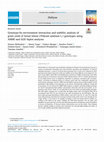
Haylon, 2024
Bread wheat is a vital staple crop worldwide; including in Ethiopia, but its production is prone ... more Bread wheat is a vital staple crop worldwide; including in Ethiopia, but its production is prone to
various environmental constraints and yield reduction associated with adaptation. To identify
adaptable genotypes, a total of 12 bread wheat genotypes (G1 to G12) were evaluated for their
genotype-environment interaction (GEI) and stability across three different environments for two
years using Additive Main Effect and Multiplicative Interaction (AMMI) and genotype main effect
plus genotype-by-environment interaction (GGE) biplots analysis. GEI is a common phenomenon
in crop improvement and is of significant importance in genotype assessment and recommendation. According to combined analysis of variance, grain yield was considerably impacted by
environments, genotypes, and GEI. AMMI and GGE biplots analysis also provided insights into the
performance and stability of the genotypes across diverse environmental conditions. Among the
12 genotypes, G6 was selected by AMMI biplot analysis as adaptive and high-yielding genotype;
G5 and G7 demonstrated high stability and minimal interaction with the environment, as evidenced by their IPCA1 values. G7 was identified as the most stable and high-yielding genotype.
The GGE biplot’s polygon view revealed that the highest grain yield was obtained from G6 in
environment three (E3). E3 was selected as the ideal environment by the GGE biplot. The top
three stable genotypes identified by AMMI stability value (ASV) were G5, G7, and G10, while the
most stable genotype determined by Genotype Selection Index (GSI) was G7. Even though G6 was
a high yielder, it was found to be unstable according to ASV and ranked third in stability according to GSI. Based on the study’s findings, the GGE biplot genotype view for grain yield
identified Tay genotype (G6) to be the most ideal genotype due to its high grain yield and stability
in diverse environments. G7 showed similar characteristics and was also stable. These findings
provide valuable insights to breeders and researchers for selecting high-yielding and stable, as
well as high-yielding specifically adapted genotypes.

BioMed research international, 2024
Background: Blood donation is the process of collecting blood from donors who are at low risk for... more Background: Blood donation is the process of collecting blood from donors who are at low risk for infection and are unlikely to jeopardize their health by blood donation. It is a lifesaving practice for people who have lost ample volumes of blood as a result of accidents, obstetric and gynecological bleeding, severe anemia, and cancer. Aim: This study is aimed at assessing knowledge, attitude, practice, and associated factors toward voluntary blood donation in Chagni, Dangila, Injibara, and Jawi towns. Subject and Methods: A community-based cross-sectional study design and multistage sampling technique were employed. The data was analyzed using SPSS version 26. Both descriptive statistics and the multivariate logistic regression model were employed to determine the significance. The association between blood donation knowledge, attitude, practice, and sociodemographic variables was tested using multivariate logistic regression. Results: In Chagni, 110 (55.6%), Dangila, 162 (79.0%), Injibara, 139 (73.5%), and Jawi, 165 (64.5%), towns had adequate knowledge regarding voluntary blood donation. In Chagni, 141 (74.6%), Dangila, 170 (66.4%), Injibara, 168 (82.0%), and Jawi, 148 (74.7%), towns had an adequate attitude regarding voluntary blood donation. In Chagni, 28 (14.1%), Dangila (15.3%), Injibara (29.3%), and Jawi (12.3%), towns practiced voluntary blood donation. Respondents&#39; sex, education level, and age were found to be significantly associated with knowledge, attitude, and practice of blood donation. Those who had a degree and above were more likely (AOR = 9 239, 5.789, 5.468, and 9.72 at 95% CI) to know about blood donation relative to those who could not read and write in Chagni, Dangila, Injibara, and Jawi, respectively. Conclusion: The majority of respondents had adequate knowledge and attitudes toward blood donation but had lower practices toward voluntary blood donation.
Journal of ethnobiology and ethnomedicine, May 30, 2024
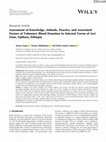
Wiley, 2024
Background: Blood donation is the process of collecting blood from donors who are at low risk for... more Background: Blood donation is the process of collecting blood from donors who are at low risk for infection and are unlikely to jeopardize their health by blood donation. It is a lifesaving practice for people who have lost ample volumes of blood as a result of accidents, obstetric and gynecological bleeding, severe anemia, and cancer. Aim: This study is aimed at assessing knowledge, attitude, practice, and associated factors toward voluntary blood donation in Chagni, Dangila, Injibara, and Jawi towns. Subject and Methods: A community-based cross-sectional study design and multistage sampling technique were employed. The data was analyzed using SPSS version 26. Both descriptive statistics and the multivariate logistic regression model were employed to determine the significance. The association between blood donation knowledge, attitude, practice, and sociodemographic variables was tested using multivariate logistic regression. Results: In Chagni, 110 (55.6%), Dangila, 162 (79.0%), Injibara, 139 (73.5%), and Jawi, 165 (64.5%), towns had adequate knowledge regarding voluntary blood donation. In Chagni, 141 (74.6%), Dangila, 170 (66.4%), Injibara, 168 (82.0%), and Jawi, 148 (74.7%), towns had an adequate attitude regarding voluntary blood donation. In Chagni, 28 (14.1%), Dangila (15.3%), Injibara (29.3%), and Jawi (12.3%), towns practiced voluntary blood donation. Respondents' sex, education level, and age were found to be significantly associated with knowledge, attitude, and practice of blood donation. Those who had a degree and above were more likely (AOR = 9 239, 5.789, 5.468, and 9.72 at 95% CI) to know about blood donation relative to those who could not read and write in Chagni, Dangila, Injibara, and Jawi, respectively. Conclusion: The majority of respondents had adequate knowledge and attitudes toward blood donation but had lower practices toward voluntary blood donation.
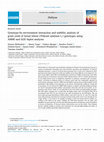
Elsevier Ltd., 2024
Bread wheat is a vital staple crop worldwide; including in Ethiopia, but its production is prone ... more Bread wheat is a vital staple crop worldwide; including in Ethiopia, but its production is prone to
various environmental constraints and yield reduction associated with adaptation. To identify
adaptable genotypes, a total of 12 bread wheat genotypes (G1 to G12) were evaluated for their
genotype-environment interaction (GEI) and stability across three different environments for two
years using Additive Main Effect and Multiplicative Interaction (AMMI) and genotype main effect
plus genotype-by-environment interaction (GGE) biplots analysis. GEI is a common phenomenon
in crop improvement and is of significant importance in genotype assessment and recommendation. According to combined analysis of variance, grain yield was considerably impacted by
environments, genotypes, and GEI. AMMI and GGE biplots analysis also provided insights into the
performance and stability of the genotypes across diverse environmental conditions. Among the
12 genotypes, G6 was selected by AMMI biplot analysis as adaptive and high-yielding genotype;
G5 and G7 demonstrated high stability and minimal interaction with the environment, as evidenced by their IPCA1 values. G7 was identified as the most stable and high-yielding genotype.
The GGE biplot’s polygon view revealed that the highest grain yield was obtained from G6 in
environment three (E3). E3 was selected as the ideal environment by the GGE biplot. The top
three stable genotypes identified by AMMI stability value (ASV) were G5, G7, and G10, while the
most stable genotype determined by Genotype Selection Index (GSI) was G7. Even though G6 was
a high yielder, it was found to be unstable according to ASV and ranked third in stability according to GSI. Based on the study’s findings, the GGE biplot genotype view for grain yield
identified Tay genotype (G6) to be the most ideal genotype due to its high grain yield and stability
in diverse environments. G7 showed similar characteristics and was also stable. These findings
provide valuable insights to breeders and researchers for selecting high-yielding and stable, as
well as high-yielding specifically adapted genotypes.
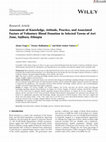
Belsti Atnkut Tadesse, 2024
Background: Blood donation is the process of collecting blood from donors who are at low risk for... more Background: Blood donation is the process of collecting blood from donors who are at low risk for infection and are unlikely to jeopardize their health by blood donation. It is a lifesaving practice for people who have lost ample volumes of blood as a result of accidents, obstetric and gynecological bleeding, severe anemia, and cancer. Aim: This study is aimed at assessing knowledge, attitude, practice, and associated factors toward voluntary blood donation in Chagni, Dangila, Injibara, and Jawi towns. Subject and Methods: A community-based cross-sectional study design and multistage sampling technique were employed. The data was analyzed using SPSS version 26. Both descriptive statistics and the multivariate logistic regression model were employed to determine the significance. The association between blood donation knowledge, attitude, practice, and sociodemographic variables was tested using multivariate logistic regression. Results: In Chagni, 110 (55.6%), Dangila, 162 (79.0%), Injibara, 139 (73.5%), and Jawi, 165 (64.5%), towns had adequate knowledge regarding voluntary blood donation. In Chagni, 141 (74.6%), Dangila, 170 (66.4%), Injibara, 168 (82.0%), and Jawi, 148 (74.7%), towns had an adequate attitude regarding voluntary blood donation. In Chagni, 28 (14.1%), Dangila (15.3%), Injibara (29.3%), and Jawi (12.3%), towns practiced voluntary blood donation. Respondents' sex, education level, and age were found to be significantly associated with knowledge, attitude, and practice of blood donation. Those who had a degree and above were more likely (AOR = 9 239, 5.789, 5.468, and 9.72 at 95% CI) to know about blood donation relative to those who could not read and write in Chagni, Dangila, Injibara, and Jawi, respectively. Conclusion: The majority of respondents had adequate knowledge and attitudes toward blood donation but had lower practices toward voluntary blood donation.

Background Feeding the world's future population while still facing a variety of socioeconomic an... more Background Feeding the world's future population while still facing a variety of socioeconomic and climate change scenarios with uncertain outcomes is a key global societal concern that should be addressed in a science-based manner. Ethiopia boasts a great diversity of wild edible plant species (WEPS), but millions of its citizens still suffer from chronic hunger every year. In this context, we here document the use and conservation of WEPS in the Awi Agäw community, Northwestern Ethiopia. Methods We performed a cross-sectional study from October 2021 to June 2022. Ethnobotanical and conservation status data were collected via semi-structured interviews, focus group discussions, field walks and market surveys. A total of 374 respondents from three districts (Guangua, Jawi and Ankasha) were purposely selected for the study. Descriptive statistics, including preference rankings, frequencies and direct matrix rankings, were employed for the data analysis. Results We identified a total of 39 WEPS plant taxa distributed among 26 families and 32 genera. The Moraceae and Rosaceae had the greatest numbers of plants, with five and three species, respectively. The WEPS are regularly consumed in the study area to alleviate hunger. However, threats such as habitat loss, agricultural expansion, deforestation for firewood and other reasons, and pesticide use threaten WEPS availability. Conclusion Therefore, community-based conservation interventions need to be encouraged to safeguard WEPS and associated traditional knowledge. Furthermore, nutritional quality analysis is recommended for the selection of promising WEPS candidates.

Journal of Experimental Agriculture International, 2019
Background and Objective: Castor (Ricinus communis L.) is a diploid plant with chromosome number ... more Background and Objective: Castor (Ricinus communis L.) is a diploid plant with chromosome number of 2n=20 which belongs to family of Euphorbiaceous and genus Ricinus. Correlation alone is not efficient for variability studies. So, it should be in conjugation with Path co- efficient analysis to know the direct and indirect effects. This study was conducted to assess the role of evaluating path coefficient analysis in castor. Materials and Methods: A Field experiment was carried out to determine direct and indirect effects of yield and its components in castor accessions at Melkassa, central rift valley of Ethiopia under irrigation in 2014. The experiment was conducted using a randomized complete block design with 3 replications and a total of 48 castor accessions were evaluated. Results: Number of capsules per plant, number of primary branches per plant, length of inter node and hundred seed weight had exerted positive direct effect for both at phenotypic and genotypic path analysis...
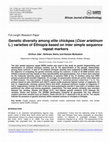
African Journal of Biotechnology
The inter simple sequence repeat (ISSR) marker was used in this study for genetic fingerprinting ... more The inter simple sequence repeat (ISSR) marker was used in this study for genetic fingerprinting and identification of released chickpea varieties and for the determination of the genetic relationships among these cultivars. A total of 19 released chickpea varieties were subjected to ISSR analysis with the objective of evaluating the genetic diversity among the cultivars. A total of 20 ISSR primers were initially screened and later based on their reproducibility and polymorphism, four of them were selected for the molecular diversity assay. Amplification of genomic DNA of the 19 varieties using four ISSR primers produced 38 scorable fragments. On average, 9.5 polymorphic bands per primer were observed in ISSR analysis. The total number of bands amplified by 3' anchored primers varied from 7 to 12. The primers based on poly (GGAGA) and (AG)YT repeat motifs produced highest number of fragments (10 and 12, respectively), whereas, primers GACA and (GA)T, produced minimum number of fragments (7 and 9, respectively). Overall, 81.58% of the loci were polymorphic and 96.17 and 3.83% of variation were partitioned into within and among population, respectively. The least genetic similarity was recorded between the varieties, Shasho and Minjar (0.41), and highest genetic similarity (0.97) between the varieties, Worku and Kutaye. The UPGMA dendrogram clustered all genotypes into four different clusters and three varieties such as Shasho, Chefe and DZ-10-11 observed to be an out lie. The results indicate the presence of genetic diversity within released cultivars of chickpea in Ethiopia.

A field experiment was conducted to study the genetic variability and association of characters a... more A field experiment was conducted to study the genetic variability and association of characters among yield and yield-related traits in castor accessions at Melkassa, central rift valley of Ethiopia during the off season of the 2013/2014. A total of 48 castor accessions were evaluated by using randomized complete block design with three replications. Analysis of variance revealed that there was highly significant difference among the accessions for most of the characters studied. For all traits, phenotypic coefficient of variation was highly higher than genotypic coefficient of variation; this indicates that there was environmental influence on these traits. Those characters which brought high heritability and genetic advance including the moderate one indicate that these characters could be improved through selection easily. Seed yield had positive and significant phenotypic and genotypic association with number of capsules per plant (NCP), number of seeds per plant (SP), number of...
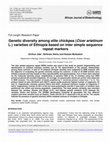
The inter simple sequence repeat (ISSR) marker was used in this study for genetic fingerprinting ... more The inter simple sequence repeat (ISSR) marker was used in this study for genetic fingerprinting and identification of released chickpea varieties and for the determination of the genetic relationships among these cultivars. A total of 19 released chickpea varieties were subjected to ISSR analysis with the objective of evaluating the genetic diversity among the cultivars. A total of 20 ISSR primers were initially screened and later based on their reproducibility and polymorphism, four of them were selected for the molecular diversity assay. Amplification of genomic DNA of the 19 varieties using four ISSR primers produced 38 scorable fragments. On average, 9.5 polymorphic bands per primer were observed in ISSR analysis. The total number of bands amplified by 3’ anchored primers varied from 7 to 12. The primers based on poly (GGAGA) and (AG)YT repeat motifs produced highest number of fragments (10 and 12, respectively), whereas, primers GACA and (GA)T, produced minimum number of fragm...
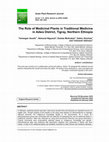
Asian Plant Research Journal
In Ethiopia, medicinal plants had been used since ancient time and became an important source of ... more In Ethiopia, medicinal plants had been used since ancient time and became an important source of health care. Though majority of the people in the study area depend on ethnomedicine to manage different ailments, the indigenous knowledge largely is not documented. As a result, an ethnobotanical survey was conducted with the objective of assessing the role of medicinal plants in traditional medicine. Data was collected by using semi-structured interview and group discussion. Twenty informants were purposefully selected based on indigenous knowledge and gender. Ethnobotanical data was analyzed with descriptive statistics and expressed in tables and flow charts. A total of 25 medicinal plants (22 families) recorded to treat human and livestock ailments. Medicinal plant habit analysis indicates that shrubs occupy the highest proportion (36%), followed by trees and herbs (28% for each) and climbers (8%). The most commonly used plant parts in the study area were leaves and roots. Although ...
Asian Journal of Biological Sciences

Journal of Experimental Agriculture International
Background and Objective: Castor (Ricinus communis L.) is a diploid plant with chromosome number ... more Background and Objective: Castor (Ricinus communis L.) is a diploid plant with chromosome number of 2n=20 which belongs to family of Euphorbiaceous and genus Ricinus. Correlation alone is not efficient for variability studies. So, it should be in conjugation with Path co- efficient analysis to know the direct and indirect effects. This study was conducted to assess the role of evaluating path coefficient analysis in castor. Materials and Methods: A Field experiment was carried out to determine direct and indirect effects of yield and its components in castor accessions at Melkassa, central rift valley of Ethiopia under irrigation in 2014. The experiment was conducted using a randomized complete block design with 3 replications and a total of 48 castor accessions were evaluated. Results: Number of capsules per plant, number of primary branches per plant, length of inter node and hundred seed weight had exerted positive direct effect for both at phenotypic and genotypic path analysis...

Uploads
Papers by destaw mullualem
various environmental constraints and yield reduction associated with adaptation. To identify
adaptable genotypes, a total of 12 bread wheat genotypes (G1 to G12) were evaluated for their
genotype-environment interaction (GEI) and stability across three different environments for two
years using Additive Main Effect and Multiplicative Interaction (AMMI) and genotype main effect
plus genotype-by-environment interaction (GGE) biplots analysis. GEI is a common phenomenon
in crop improvement and is of significant importance in genotype assessment and recommendation. According to combined analysis of variance, grain yield was considerably impacted by
environments, genotypes, and GEI. AMMI and GGE biplots analysis also provided insights into the
performance and stability of the genotypes across diverse environmental conditions. Among the
12 genotypes, G6 was selected by AMMI biplot analysis as adaptive and high-yielding genotype;
G5 and G7 demonstrated high stability and minimal interaction with the environment, as evidenced by their IPCA1 values. G7 was identified as the most stable and high-yielding genotype.
The GGE biplot’s polygon view revealed that the highest grain yield was obtained from G6 in
environment three (E3). E3 was selected as the ideal environment by the GGE biplot. The top
three stable genotypes identified by AMMI stability value (ASV) were G5, G7, and G10, while the
most stable genotype determined by Genotype Selection Index (GSI) was G7. Even though G6 was
a high yielder, it was found to be unstable according to ASV and ranked third in stability according to GSI. Based on the study’s findings, the GGE biplot genotype view for grain yield
identified Tay genotype (G6) to be the most ideal genotype due to its high grain yield and stability
in diverse environments. G7 showed similar characteristics and was also stable. These findings
provide valuable insights to breeders and researchers for selecting high-yielding and stable, as
well as high-yielding specifically adapted genotypes.
various environmental constraints and yield reduction associated with adaptation. To identify
adaptable genotypes, a total of 12 bread wheat genotypes (G1 to G12) were evaluated for their
genotype-environment interaction (GEI) and stability across three different environments for two
years using Additive Main Effect and Multiplicative Interaction (AMMI) and genotype main effect
plus genotype-by-environment interaction (GGE) biplots analysis. GEI is a common phenomenon
in crop improvement and is of significant importance in genotype assessment and recommendation. According to combined analysis of variance, grain yield was considerably impacted by
environments, genotypes, and GEI. AMMI and GGE biplots analysis also provided insights into the
performance and stability of the genotypes across diverse environmental conditions. Among the
12 genotypes, G6 was selected by AMMI biplot analysis as adaptive and high-yielding genotype;
G5 and G7 demonstrated high stability and minimal interaction with the environment, as evidenced by their IPCA1 values. G7 was identified as the most stable and high-yielding genotype.
The GGE biplot’s polygon view revealed that the highest grain yield was obtained from G6 in
environment three (E3). E3 was selected as the ideal environment by the GGE biplot. The top
three stable genotypes identified by AMMI stability value (ASV) were G5, G7, and G10, while the
most stable genotype determined by Genotype Selection Index (GSI) was G7. Even though G6 was
a high yielder, it was found to be unstable according to ASV and ranked third in stability according to GSI. Based on the study’s findings, the GGE biplot genotype view for grain yield
identified Tay genotype (G6) to be the most ideal genotype due to its high grain yield and stability
in diverse environments. G7 showed similar characteristics and was also stable. These findings
provide valuable insights to breeders and researchers for selecting high-yielding and stable, as
well as high-yielding specifically adapted genotypes.
various environmental constraints and yield reduction associated with adaptation. To identify
adaptable genotypes, a total of 12 bread wheat genotypes (G1 to G12) were evaluated for their
genotype-environment interaction (GEI) and stability across three different environments for two
years using Additive Main Effect and Multiplicative Interaction (AMMI) and genotype main effect
plus genotype-by-environment interaction (GGE) biplots analysis. GEI is a common phenomenon
in crop improvement and is of significant importance in genotype assessment and recommendation. According to combined analysis of variance, grain yield was considerably impacted by
environments, genotypes, and GEI. AMMI and GGE biplots analysis also provided insights into the
performance and stability of the genotypes across diverse environmental conditions. Among the
12 genotypes, G6 was selected by AMMI biplot analysis as adaptive and high-yielding genotype;
G5 and G7 demonstrated high stability and minimal interaction with the environment, as evidenced by their IPCA1 values. G7 was identified as the most stable and high-yielding genotype.
The GGE biplot’s polygon view revealed that the highest grain yield was obtained from G6 in
environment three (E3). E3 was selected as the ideal environment by the GGE biplot. The top
three stable genotypes identified by AMMI stability value (ASV) were G5, G7, and G10, while the
most stable genotype determined by Genotype Selection Index (GSI) was G7. Even though G6 was
a high yielder, it was found to be unstable according to ASV and ranked third in stability according to GSI. Based on the study’s findings, the GGE biplot genotype view for grain yield
identified Tay genotype (G6) to be the most ideal genotype due to its high grain yield and stability
in diverse environments. G7 showed similar characteristics and was also stable. These findings
provide valuable insights to breeders and researchers for selecting high-yielding and stable, as
well as high-yielding specifically adapted genotypes.
various environmental constraints and yield reduction associated with adaptation. To identify
adaptable genotypes, a total of 12 bread wheat genotypes (G1 to G12) were evaluated for their
genotype-environment interaction (GEI) and stability across three different environments for two
years using Additive Main Effect and Multiplicative Interaction (AMMI) and genotype main effect
plus genotype-by-environment interaction (GGE) biplots analysis. GEI is a common phenomenon
in crop improvement and is of significant importance in genotype assessment and recommendation. According to combined analysis of variance, grain yield was considerably impacted by
environments, genotypes, and GEI. AMMI and GGE biplots analysis also provided insights into the
performance and stability of the genotypes across diverse environmental conditions. Among the
12 genotypes, G6 was selected by AMMI biplot analysis as adaptive and high-yielding genotype;
G5 and G7 demonstrated high stability and minimal interaction with the environment, as evidenced by their IPCA1 values. G7 was identified as the most stable and high-yielding genotype.
The GGE biplot’s polygon view revealed that the highest grain yield was obtained from G6 in
environment three (E3). E3 was selected as the ideal environment by the GGE biplot. The top
three stable genotypes identified by AMMI stability value (ASV) were G5, G7, and G10, while the
most stable genotype determined by Genotype Selection Index (GSI) was G7. Even though G6 was
a high yielder, it was found to be unstable according to ASV and ranked third in stability according to GSI. Based on the study’s findings, the GGE biplot genotype view for grain yield
identified Tay genotype (G6) to be the most ideal genotype due to its high grain yield and stability
in diverse environments. G7 showed similar characteristics and was also stable. These findings
provide valuable insights to breeders and researchers for selecting high-yielding and stable, as
well as high-yielding specifically adapted genotypes.